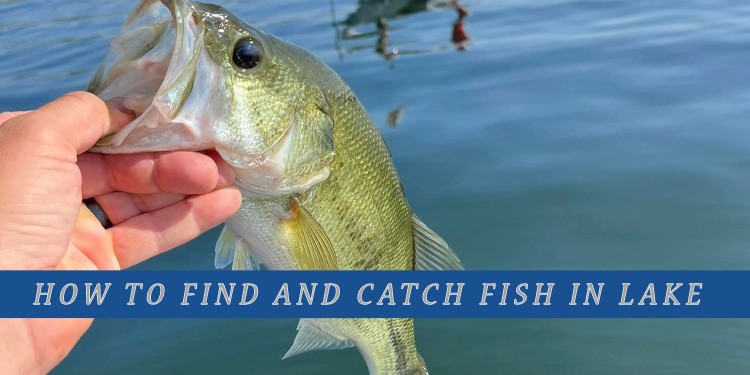Lakes are often abundant in fish due to ample food sources and shelter, making them favorable habitats for various fish species.
However, whether it’s easy to find fish in a lake depends on several factors. The presence of natural structures like submerged logs, rock formations, and dense underwater vegetation, as well as man-made structures, often attract fish, serving as prime fishing spots. Additionally, fish movement within lakes is influenced by factors like water temperature, availability of food, breeding patterns, and seasonal changes.
To locate good fishing spots, one should observe these factors, look for areas with notable water activity, and even use tools like fish finders.
Once you’ve identified a potential spot, the right gear, including an appropriate rod, reel, line, hooks, and bait, is essential for a successful fishing experience in a lake. Combining knowledge of the lake’s features with the right equipment can significantly enhance your chances of a good catch.
So, if you’re just starting out and eager to dive into the world of lake fishing, our detailed guide is packed with the tips and techniques to find and catch fish in a lake like a pro!
How to find fish in a lake
Finding fish in a lake involves understanding their behavior, habitat, and the factors that influence their location.
Lake fish are constantly searching for two primary things: food and cover. They gravitate towards areas where they can easily find food, such as insect larvae, smaller fish, or aquatic plants, and places that offer protection from predators.
This is why understanding the lake structure is crucial. Structures like submerged objects, rock formations, and underwater ridges often become prime fish spots because they offer food and cover.
Water temperature plays a significant role in determining the location of fish within a lake. Fish are cold-blooded animals (with few exceptions) and are directly influenced by the temperature of their environment. Given this sensitivity to temperature, fish concentrate in areas of the lake where the conditions are optimum. Understanding these temperature-driven behaviors can greatly aid in locating fish in a lake, regardless of the season.
Some general hacks for finding fish in a lake include:
- Look for visible structures like fallen trees, rock formations, or weed beds, as fish often gather near them for food and cover.
- Target to fish during the early morning or late evening in summer, and during the late morning to early afternoon in transitional seasons like spring and fall.
- Observe water birds like herons or kingfishers; their presence might indicate a good fishing spot.
- Use a fish finder to get the visual representation of where fish might be located in relation to the lake’s structure and depth.
- Seek advice from local guides, anglers, or bait shops. They can guide you to known fishing spots in a particular lake.
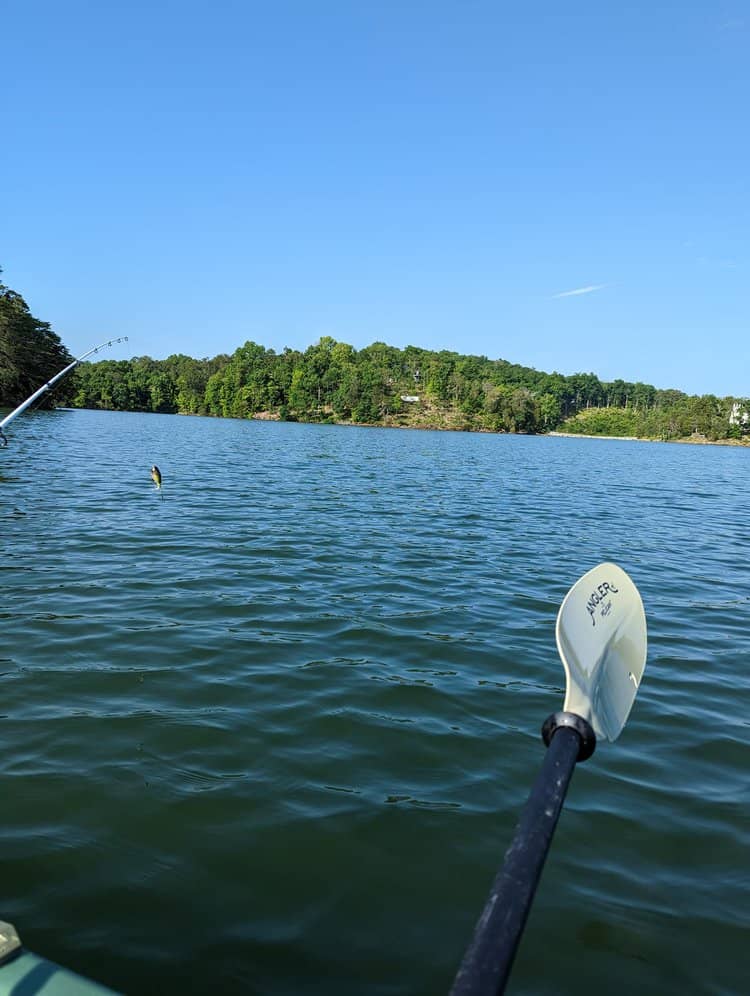
Where to find fish in Lake
Cover
In fishing terminology, “cover” refers to physical objects in the water, both natural and man-made, that fish use to hide, seek protection, or ambush prey. Cover also provides shade and cooler water for fish, especially on hot summer days. Examples of cover include submerged trees, aquatic vegetation, rock piles, docks, and sunken man-made structures.
Recognizing the types of cover in a body of water can help pinpoint where fish might be hiding or feeding.
Here are some important Covers to find fish in a lake:
1. Docks and Piers
Docks and piers are man-made structures that extend over the water. They can be made from wood, metal, or concrete, and they often serve as spots for boats to tie up or for people to fish from.
What time of the day and season do they hold fish?
Docks and piers are most productive during the warmer parts of the day when the sun is high, as they provide shade and cooler water for fish. They can be especially productive in the summer and early fall.
Where to find it in a lake?
Docks and piers are commonly found along the shoreline of lakes, near residential properties, marinas, or public access points.
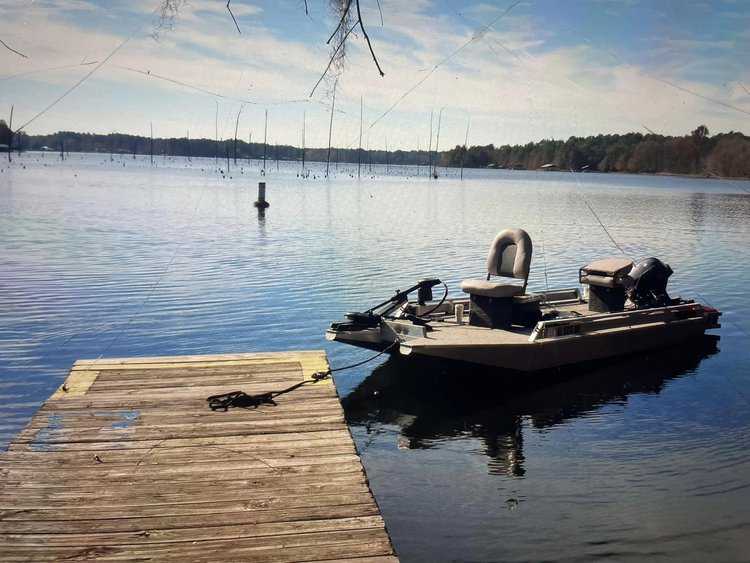
2. Stumps and Fallen Trees
Stumps refer to the remains of cut or dead trees that protrude from the water. Fallen trees, often called “laydowns” by anglers, are trees that have toppled over into the water.
What time of the day and season do they hold fish?
Fish can be found around stumps and fallen trees throughout the day, but early morning and late afternoon might be especially productive when predatory fish are actively feeding. These structures can hold fish throughout the year, but spring and early summer are particularly good when fish are spawning or seeking shelter from the heat.
Where to find it in a lake?
Stumps and fallen trees can be found throughout a lake, but are especially common in shallow areas, near the shoreline, or in coves. Areas where logging occurred or where trees naturally fall due to erosion or storms are prime spots.
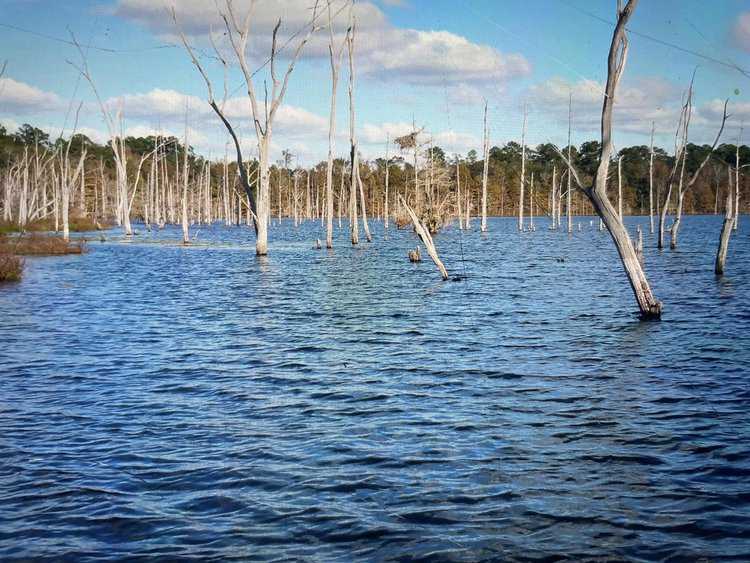
3. Rocks and Boulders
Rocks and boulders are naturally occurring hard substrates that can vary in size from small pebbles to large formations. “Rockpiles” is a term used by anglers to describe accumulations or clusters of rocks and boulders in a body of water.
What time of the day and season do they hold fish?
Rocks and boulders tend to be most productive during early morning and late afternoon. In terms of seasons, spring and fall are especially productive when fish come to rocky areas for spawning or feeding on organisms that inhabit these structures.
Where to find it in a lake?
Rocks and boulders can be found in various parts of a lake. They might be present along the shoreline, around islands, or in deeper parts of the lake, especially near drop-offs or ridges.
4. Aquatic Vegetation
Aquatic vegetation refers to plants that grow in or under water, including weeds, lily pads, reeds, and hydrilla.
What time of the day and season do they hold fish?
During the warmer parts of the day, fish might seek refuge in aquatic vegetation for shade and cooler water. Summer and early fall are prime times, especially when the vegetation is dense and provides ample cover.
Where to find it in a lake?
Aquatic vegetation is typically found in shallower areas of a lake, near the shoreline, in coves, or in flats. The presence and type of vegetation can vary based on water clarity and nutrient levels.
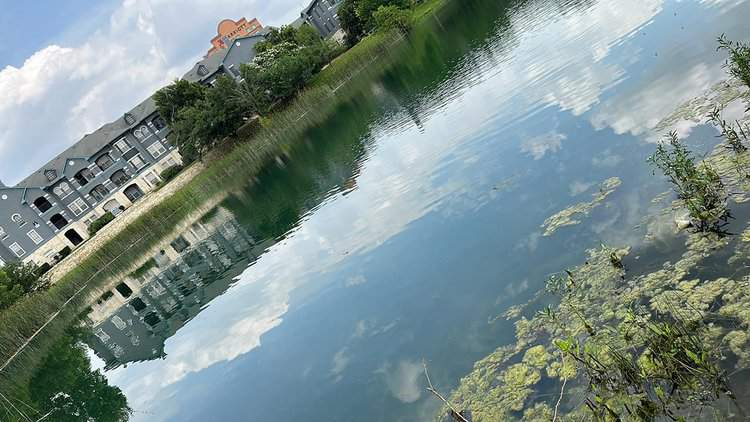
5. Brush Piles
Brush piles are clusters of branches, twigs, and sometimes larger parts of trees that are either naturally accumulated or intentionally placed by anglers to attract fish.
What time of the day and season do they hold fish?
Early morning and late afternoon are often the best times to fish brush piles. They can attract fish in all seasons, but spring through early fall are especially good due to increased fish activity and the shelter brush piles provide.
Where to find it in a lake?
Brush piles can be located both in shallow and deeper waters. They might be found near the shoreline, especially if they’ve been formed naturally by fallen trees or branches. Some anglers or lake managers also submerge brush piles in deeper parts of the lake to create habitat.
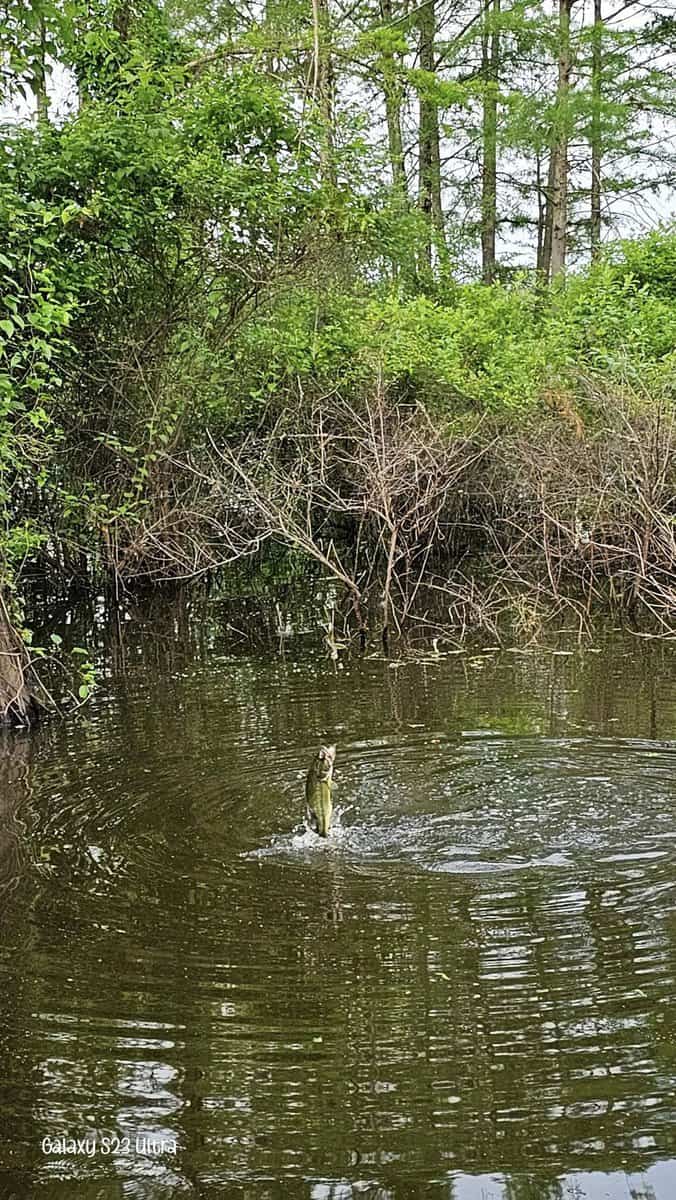
Structures
Structures are naturally occurring or man-made features that affect underwater topography. They provide depth, breaks, and pathways that fish use for movement, spawning, or seeking food.
Here are some important structures in a lake to find fish:
1. Drop-offs
Drop-offs are areas in a body of water where there’s a significant depth change over a short distance. Think of it like an underwater cliff where the lake’s floor suddenly descends from shallow to deeper water.
Fish, especially predatory species, use these areas to move between shallow feeding zones and deeper resting areas. This movement makes drop-offs prime spots to find fish.
What time of the day and season do they hold fish?
Drop-offs are particularly effective during warmer periods when fish might seek the cooler, deeper waters adjacent to the drop-off. In terms of seasons, they’re especially active in the summer and winter, serving as transitional zones for fish seeking optimal water temperatures.
Where to find it in a lake?
Drop-offs can be located throughout a lake, often where flats or plateaus end and give way to deeper sections of the lake. They might also be found adjacent to points or near the mouths of tributaries.
2. Ledges
Ledges are similar to drop-offs but often refer to a more gradual descent or a series of steps in the lake’s floor, rather than a sharp drop. They can be thought of as underwater terraces.
What time of the day and season do they hold fish?
Like drop-offs, ledges can also attract fish throughout the day. They’re especially productive during transitional times, like dawn and dusk, when predatory fish might use them as ambush points. Seasonally, ledges can be hotspots during summer and winter, providing fish with both feeding opportunities and temperature refuge.
Where to find it in a lake?
Ledges can be found in various parts of a lake, especially where there’s a transition between shallow and deep water. They might be located near points, along channels, or around submerged structures.
3. Points
Points are areas where the land or lake bed extends or protrudes out into the main body of the lake.
What time of the day and season do they hold fish?
Points can be productive throughout the day, but especially during early morning and late afternoon when fish use them as feeding areas. Seasonally, spring and fall are particularly active times on points.
Where to find it in a lake?
Points are usually found jutting out from the shoreline. They can be easily identified even from the surface due to the land protrusion.
4. Inlets and Outlets
Inlets are areas where water flows into a lake, often from rivers, streams, or creeks. Outlets are the opposite; they’re where water flows out of the lake, leading to another water body or continuing as a river or stream.
What time of the day and season do they hold fish?
Inlets and outlets can be active fishing spots throughout the day. They’re especially productive in spring and fall when water movement can bring in food and nutrients, attracting fish.
Where to find it in a lake?
These are typically located at the edges or ends of a lake. Inlets are often at the upper parts of a lake, while outlets are at the lower ends.
Shoreline
Shorelines offer best fishing spots in a lake, especially for anglers without a boat or those looking for easily accessible spots. The reasons why shorelines are productive for fishing include:
- Food Availability: Shorelines are often rich in aquatic insects, crustaceans, and other small organisms. These attract baitfish, which in turn draw in larger predatory fish.
- Vegetation: The edges of lakes often have aquatic vegetation like lily pads, reeds, and emergent plants. These vegetative areas provide cover for fish, offer higher oxygen levels, and serve as excellent spots for predators to ambush prey.
- Shallow Waters: During certain times of the day or seasons, fish move to shallow waters to feed, especially during the early morning or late evening. Shorelines provide access to these shallower zones.
- Structures and Cover: Natural structures such as fallen trees, rocks, or man-made structures like docks along the shoreline offer fish places to hide, rest, and hunt.
- Spawning: Many fish species choose shallow, protected areas along shorelines for spawning during certain times of the year.
To find fish near the shoreline in a lake:
- Observe the Water: Look for signs of fish activity, like ripples, jumping fish, or birds diving into the water.
- Identify Key Structures and Cover: Focus on areas with visible structures like rocks, fallen trees, or patches of aquatic vegetation. Such spots are more likely to hold fish.
- Use Polarized Sunglasses: These can help reduce glare and allow you to see into the water better, making it easier to spot fish or underwater structures.
- Look for Shade: Fish often seek refuge in shaded areas during the warmer parts of the day. Overhanging trees, docks, or any other structure casting a shadow can be potential hotspots.
- Pay Attention to Depth: Even within the shoreline, there can be variations in depth. Drop-offs or sudden changes in depth near the shore can be particularly attractive to fish.
Using Water Temperature to Find Fish
Water temperature plays a pivotal role in influencing fish behavior, movement, and location within a lake. In response to changing temperatures throughout the year, fish in lakes often undergo seasonal migrations. Here’s a general overview of where to fish lake during each season.
Spring
In spring, fishing is generally poor in the early morning due to cold water temperatures. It improves from late morning to early afternoon as the water warms up, especially along downwind shorelines. By afternoon and early evening, fishing is good as the fish are more active with higher metabolism.
Best lake fishing spots during spring are:
- Shallow Areas: As the water begins to warm up, fish move to shallower areas for both food and spawning. Look for them near shoreline.
- Near Spawning Beds: Species like bass, crappie, and bluegill create nesting beds in shallow waters. They can be especially aggressive during this period.
- Inlets: Moving water from melting snow and spring rains can bring food into the lakes, making areas near inlets particularly active.
Summer
During summer, early morning and late evening are the best times for fishing. The fish retreat to deeper waters to cool off during the heat of the day, making fishing challenging from late morning to early afternoon.
Here is where to find fish in lake during summer:
- Deeper Waters: As temperatures rise, many fish seek deeper, cooler waters, especially during the heat of midday. Look for them around drop-offs, ledges, and deeper structures.
- Shaded Areas: Fish look for cooler waters in lakes under lily pads, docks, overhanging trees, or other structures that provide shade.
- Weed Beds: Aquatic vegetation can provide cooler temperatures and abundant food, attracting various species.
Fall
In fall, early morning fishing is not very productive due to cool waters. Afternoon to early evening is considered one of the best times to fish, as the water is more comfortable for fish and they are actively feeding to prepare for winter.
Fall season concentrate the lake fish in:
- Shallow Areas: As the water cools, fish move back to shallower waters in search of food. Areas that were hot in summer can become productive again.
- Near Baitfish Schools: Fall is when baitfish often school up and become a primary food source for predatory fish. Look for active baitfish near the surface.
- Points and Drop-offs: These can serve as transition zones where fish move between deep and shallow waters.
Winter
In winter fish become less active and their metabolism slows down. They often retreat to deeper waters where temperature fluctuations are less drastic.
Fish are concentrated in these areas of lake duing winter:
- Deep Waters: Cold temperatures push many fish species to deeper parts of the lake where the water is more stable and slightly warmer.
- Spring Holes: Areas in the lake fed by underground springs can be warmer than surrounding waters and attract fish.
- Near Structure: Fish are generally less active in winter. They often stay close to structures like submerged trees, rocks, or humps where they can find both cover and occasional food.
Tips to Quickly find fish in lake
The following tips can help beginners quickly find fishing spots in any lake:
1. Use Fish Finder
A fish finder is an electronic device that uses sonar to detect and display the underwater environment on a screen. This includes showing fish, the lake’s depth, and the bottom structure.
A best fish finder model in the market can:
- Clearly indicate the presence of fish with symbols or arches.
- Show depth contours, helping you identify drop-offs, humps, and other structures where fish might congregate.
- Display underwater vegetation and other potential fish covers.
- In advanced models, even differentiate between fish sizes or show temperature gradients.
Below is an example of the fish finder sonar image that clearly shows fish and structure.
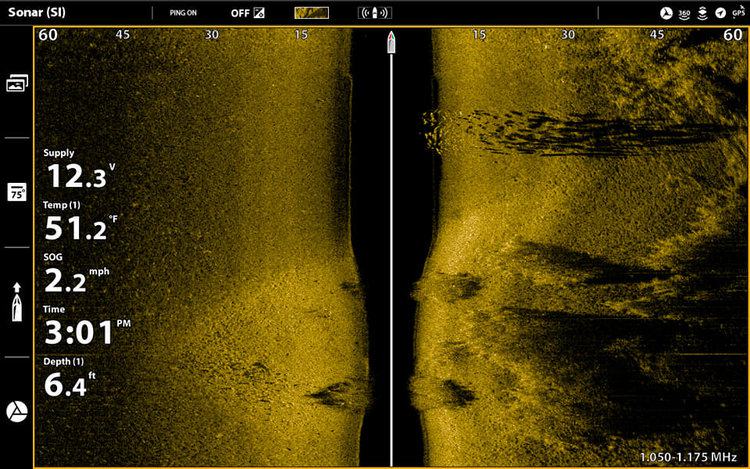
2. Use Lake Fishing Maps
Lake fishing maps, often called topographical or contour maps, provide detailed information about the lake topography. They show depth contours, structures, and sometimes specific habitats or known fishing spots. By using lake fishing maps, you can:
- Identify potential fishing spots like drop-offs, channels, humps, and points without having to physically explore the entire lake.
- Plan your fishing strategy based on the lake’s layout.
- Locate deeper or shallower areas depending on the season or time of day.
- Cross-reference with personal experience or local advice to pinpoint productive areas.
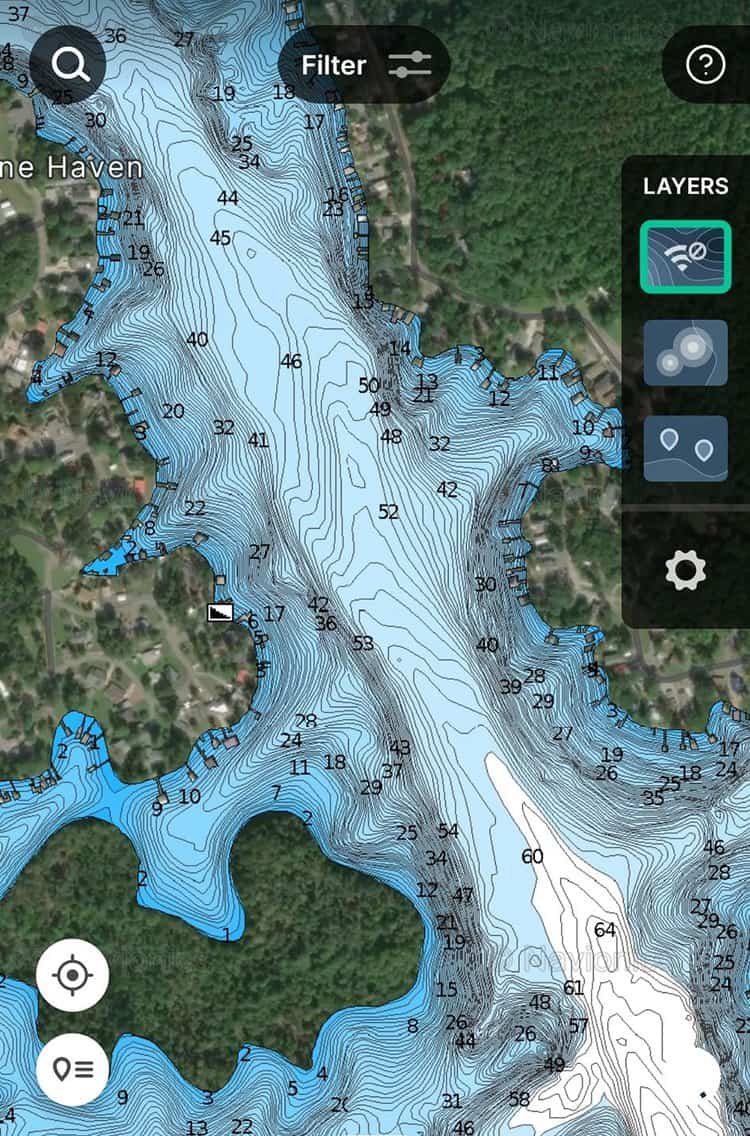
3. Use Underwater Cameras
Underwater cameras are devices designed to capture video or images beneath the water’s surface. They can be attached to a cable and lowered to specific depths, giving you a direct visual of the underwater environment. With underwater cameras, you can:
- Get a clear, visual confirmation of fish presence and even identify species.
- Observe fish behavior, helping you adjust your tactics (e.g., seeing how fish react to certain lures or baits).
- Inspect the underwater environment in detail, identifying types of vegetation, substrate, and other structures.
- Validate or enhance findings from fish finders or maps with direct visual evidence.
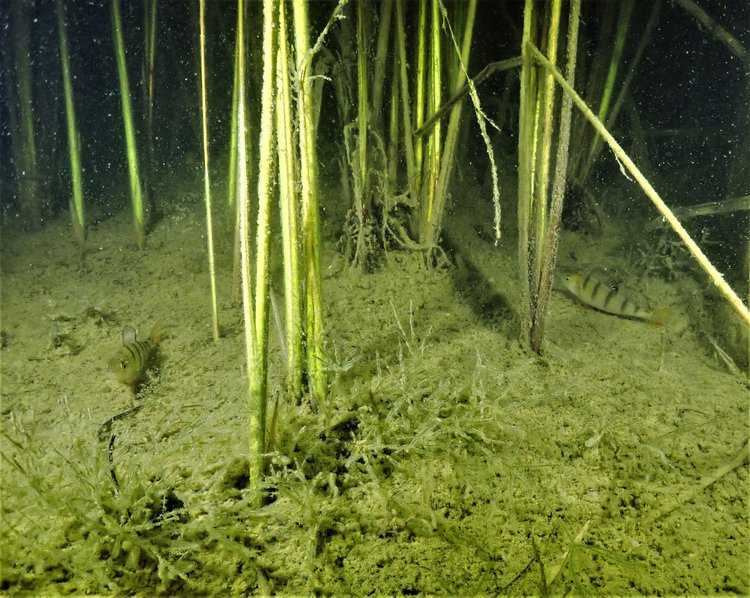
4. Use Polarized Sunglasses
Polarized sunglasses are designed to reduce glare from surfaces, especially water. They enhance visual clarity and contrast by filtering out horizontally reflected light. With polarized sunglasses, you can:
- See beneath the water’s surface more clearly, making it easier to spot fish or underwater structures.
- Identify areas of aquatic vegetation or other potential fish habitats.
- Reduce eye strain during bright conditions, allowing for longer and more focused observation.
5. Ask Local Guides, Bait Shops, or Anglers
Local guides, bait shops, and experienced anglers are familiar with a particular lake or fishing spot due to frequent visits or professional expertise. By consulting with local experts, you can:
- Gain insights based on years of experience and observation.
- Learn about specific spots that are currently productive or historically known for good catches.
- Get advice on effective techniques, baits, or lures for the area.
- Understand seasonal patterns or recent changes in fish behavior.
6. Observe Feeding Birds
Birds, especially waterfowl like herons, egrets, or kingfishers, often feed on fish or aquatic organisms. Observing feeding birds can:
- Indicate areas with a high concentration of fish or baitfish.
- Serve as a visual cue to active feeding zones.
- Help in identifying shallow areas or flats where birds can easily catch fish, suggesting the presence of fish schools.
7. Experiment with Different Baits and Lures
This involves switching between various baits (like worms, minnows, or insects) and artificial lures (like spinners, jigs, or crankbaits) to see which one attracts fish the most. By experimenting, you can:
- Determine the preferences of fish during a specific time, season, or condition.
- Attract different species of fish, broadening your catch possibilities.
- Adapt to changing fish behavior or feeding patterns throughout the day.
- Identify the depth at which fish are active based on the dive range of certain lures.
How to Catch Fish in Lake
1. Get Licenses/Permits
To fish legally, most regions require anglers to have a valid fishing license or permit. These licenses help in conservation efforts and ensure sustainable fishing practices.
In many U.S. states, there are separate licenses for freshwater and saltwater fishing. If you’re fishing in a lake, you’d typically need a freshwater license.
Some lakes, especially those in protected areas or parks, might require an additional special permit or have specific regulations about fishing seasons, allowed methods, or bag limits.
Fishing licenses and permits serve multiple purposes. They help in funding conservation efforts, managing fish populations, and ensuring that anglers adhere to best practices, ensuring that fishing remains sustainable and enjoyable for future generations.
After getting your fishing license, you are all set to start fishing.
2. Target Species
Before you start fishing, it’s essential to identify which fish species you’re aiming to catch. Lakes can house a variety of fish, and knowing your target will help tailor your approach. For example:
- If you’re targeting largemouth bass in a lake, you might focus on areas with a lot of cover like submerged logs or weed beds, using lures that mimic their prey like crankbaits or rubber worms.
- If you’re after trout, cooler, deeper waters or areas near inlets might be more productive, and you might opt for live bait like worms or artificial flies.
Different fish have unique habitats, behaviors, and preferences. By identifying a target species, you can optimize your location, bait, and technique to increase your chances of a successful catch.
3. Choose Fishing Method
The method of fishing you choose can vary based on the fish species, the lake’s conditions, and your personal preferences. Each method has its techniques, equipment, and strategies. Some popular fishing methods are:
- Fly Fishing: Often used for trout or salmon in lakes, this method involves using lightweight artificial flies and a specific casting technique.
- Baitcasting: Ideal for targeting larger species like bass or pike, baitcasting allows for precise lure placements, especially near cover.
- Spinning: A versatile method suitable for many species in a lake, from bass to panfish.
- Trolling: This involves dragging lures behind a moving boat, suitable for large lakes and targeting species like walleye or larger trout.
Each fishing method is designed to present the bait or lure in a manner that’s most enticing to specific fish species under particular conditions. Your choice can significantly impact your success rate.
4. Get Fishing Gear
Once you’ve decided on the species and fishing method, it’s essential to equip yourself with the appropriate gear. Here is the list of equipment you need for the best lake fishing experience:
- Rods and Reels: Depending on your target species and method, you might choose a spinning rod and reel combo for versatility, a baitcasting setup for precision, or a fly rod for specific species like trout. For instance, a medium action spinning rod and reel combo is often a good all-around choice for various lake fish.
- Fishing Line: A versatile choice for many lake species would be a monofilament line in the 6-12 lb test range. However, for bigger species or dense cover, you might opt for a braided line or a higher test weight.
- Tackle: This includes hooks, weights, bobbers, swivels, and lures. The type and size will depend on the species you’re targeting. For bass, for example, you might pack soft plastics, crankbaits, and topwater lures. For panfish, smaller hooks and bobbers would be more appropriate.
- Terminal Tackle Box: A good tackle box helps organize your hooks, lures, sinkers, and other small equipment.
- Net: A landing net assists in safely and ethically landing fish, reducing the stress and potential harm to the fish.
- Polarized Sunglasses: These reduce water glare, allowing you to see into the water and spot fish or underwater structures.
- Safety Gear: Depending on the lake and its conditions, you might need life vests, a first aid kit, and other safety equipment.
Proper gear ensures you’re prepared for various situations you might encounter in a lake. It allows you to adapt to different species, depths, and fishing conditions. Additionally, the right gear ensures that fish are handled properly, promoting catch and release practices and the overall well-being of the fish.
5. Ensure Balanced Rod and Reel Setup
The rod and reel setup refers to the combination of fishing rod and reel chosen based on the target species, fishing method, and personal preference. The setup should be balanced, meaning the rod, reel, and line should match in power and capacity. The example setups for:
- Bass Fishing: For bass in lakes, many anglers opt for a medium to medium-heavy rod combined with a baitcasting or spinning reel, depending on their preference. The line might range from 8-20 lb test, based on the size of the bass in the specific lake.
- Trout Fishing: For lake trout, a medium-light to medium spinning rod paired with a spinning reel is common. Line strength might range from 4-12 lb test, depending on the trout’s size and the lake’s conditions.
The right rod and reel setup ensures you can cast effectively, feel bites or strikes, and fight the fish efficiently without over-stressing the fish or your equipment. An inappropriate setup can lead to broken gear, lost fish, or undue harm to the fish.
6. On-Site Preparations
Once you arrive at the lake, there are several steps to take before you start fishing. These preparations help ensure safety, success, and adherence to local regulations. Here is what you can do:
- Scouting: Before casting, spend some time observing the lake. Look for signs of fish activity, like jumping fish or feeding birds. Identify potential hotspots, like submerged structures, weed beds, or shaded areas.
- Gear Inspection: Ensure your rod, reel, line, and tackle are in good condition. Check for any damages, ensure reels are well-lubricated, and that the line has no frays or weak points.
- Safety Measures: If you’re using a boat, ensure you have life vests and safety equipment. Even from the shore, be aware of your surroundings, especially if the area is slippery or if there are overhead hazards when casting.
- Local Regulations: Check any posted signs or information boards for specific lake rules, like fishing seasons, allowed baits, size or bag limits, or specific areas where fishing might be prohibited.
Proper on-site preparations ensure you’re fishing effectively and safely. They also ensure that you’re respecting the environment and adhering to regulations, promoting sustainable and responsible fishing practices.
7. Cast and Fish
Casting involves projecting your bait or lure into the water using your rod and reel. The method and technique of casting vary based on the fishing setup and target species. Once the bait or lure is in the water, fishing involves techniques to attract fish, which might include reeling in a specific manner, jigging, or simply waiting. Examples:
- Spinning Reel Casting: Hold the line against the rod with your index finger, open the bail, cast out, and then close the bail. Begin retrieving the lure at a speed that matches the lure’s design and the fish’s expected activity level.
- Fly Fishing Casting: This involves a rhythmic forward and backward motion to send the lightweight fly out to the desired location.
- Fishing Techniques: Depending on the lure or bait, you might retrieve it steadily, jerk it intermittently (jigging), or let it sit, especially if using live bait.
Proper casting ensures your bait or lure reaches the desired location without scaring off fish. Different fishing techniques cater to various fish behaviors and lure designs, aiming to mimic natural prey as closely as possible.
8. Play and Land the Fish
Once a fish bites and is hooked, “playing” it refers to the process of reeling it in while managing its attempts to escape. This can involve letting it run on a controlled line, adjusting the rod angle, and reeling in when the fish is tired. Landing the fish is the final step, where the fish is brought to the boat or shore.
Playing a Fish: If a strong fish makes a powerful run, an angler might let it take out line under the drag system’s resistance, ensuring it doesn’t break the line. As the fish tires, the angler reels it in, always keeping some tension on the line.
Landing Techniques: Depending on the size and species of the fish, anglers might use a net to scoop it out of the water, use their hands (especially for catch and release), or even use tools like gaffs for larger species (though not commonly used in freshwater lake scenarios).
Playing and landing the fish properly ensures that the fish is caught without causing it undue harm or stress. It also ensures that the angler doesn’t lose the fish due to broken lines, pulled hooks, or other issues. Proper landing is especially important for catch and release, where the goal is to return the fish to the water in the best possible condition.
Lake Fishing Tips for Different Species
Lakes can host a wide variety of fish species, depending on their location, size, depth, water temperature, and other ecological factors. Here is how to find and catch some common lake fish species:
Lake Trout
Important Facts:
- Lake Trout (Salvelinus namaycush) is a freshwater char living mainly in lakes in northern North America.
- They are the largest of the chars and are known for their deep-water preferences.
- Lake Trout prefer cold waters, typically below 56°F (13°C).
- They are slow-growing but can live for several decades.
Where to Find in a Lake:
- Lake Trout are usually found in deeper, colder parts of the lake, especially during the summer months.
- During the spring and fall, they can be found in shallower waters as they move closer to the surface or shore for spawning or feeding.
How to Catch:
- Deep trolling with spoons or other deep-diving lures is a common method during summer.
- Jigging in deep waters can also be effective.
- In spring or fall, casting or trolling in shallower waters can be productive.
Rainbow Trout
Important Facts:
- Rainbow Trout (Oncorhynchus mykiss) are known for their vibrant colors and the pinkish band that runs along their side.
- They are native to the cold-water tributaries of the Pacific Ocean in Asia and North America.
- Rainbow Trout are popular game fish and are also stocked in many lakes.
Where to Find in a Lake:
- Rainbow Trout prefer cooler waters. In lakes, they can often be found near inlets or outlets where cooler water enters.
- They might also be present in deeper waters during the heat of summer or near spring holes.
How to Catch:
- Fly fishing with artificial flies is a popular method for catching Rainbow Trout.
- Spin fishing with spinners, spoons, or small crankbaits can also be effective.
- They can be enticed with live baits like worms or insects.
Bass
Important Facts:
- Bass is a common name for several species. In North America, the most popular are Largemouth Bass (Micropterus salmoides) and Smallmouth Bass (Micropterus dolomieu).
- They are known for their aggressive behavior, making them a favorite among sport anglers.
- Largemouth Bass prefer warmer waters, while Smallmouth Bass tend to prefer cooler, clearer waters.
Where to Find in a Lake:
- Largemouth Bass are often found around structures like submerged logs, vegetation, and rocks. They like warmer, shallower waters.
- Smallmouth Bass prefer rocky substrates and can be found near rocky shores, drop-offs, and underwater ridges.
How to Catch:
- Bass are opportunistic feeders. Lures like plastic worms, jigs, crankbaits, and topwater lures can be effective.
- They can also be caught using live baits like minnows or worms.
- Casting near structures or along the shoreline, especially during early morning or late afternoon, can be productive.
Catfish
Important Facts:
- Catfish are a diverse group of bottom-dwelling fish known for their whisker-like barbels.
- They have a strong sense of smell and taste, which they use to locate food.
- There are various species of catfish, with the Channel Catfish, Blue Catfish, and Flathead Catfish being some of the most popular in North America.
Where to Find in a Lake:
- Catfish are often found near the bottom of lakes, especially in areas with cover like submerged logs, rocks, or deep holes.
- They also frequent areas with muddy or sandy bottoms.
How to Catch:
- Due to their strong sense of smell, baits with a strong odor (like stink baits, chicken liver, or cut bait) are effective.
- Night fishing can be particularly productive as catfish are more active during this time.
- Bottom rigs or slip sinker rigs are commonly used setups.
Minnows
Important Facts:
- The term “minnow” generally refers to small freshwater fish, especially those used as bait. Many species fall under this broad category.
- They are often schooling fish and are prey for many larger fish species.
Where to Find in a Lake:
- Minnows can be found in various parts of a lake, from shallow waters near the shore to deeper parts.
- They are often found in schools, especially near areas with abundant plankton or other food sources.
How to Catch:
- Minnow traps, cast nets, or seines are commonly used to catch minnows for bait.
- When fishing with minnows as bait, using a bobber or float rig can be effective.
Sturgeon
Important Facts:
- Sturgeon are ancient fish known for their elongated bodies, scutes (bony plates), and barbels.
- They are slow-growing and can live for several decades. Some species can grow exceptionally large.
- Sturgeons are often sought for their roe, which is used to make caviar.
Where to Find in a Lake:
- Sturgeon are bottom-dwellers and are often found in deeper parts of lakes, especially near muddy or sandy bottoms.
- They can also be found near inlets or outlets where water currents bring in food.
How to Catch:
- Due to their size and strength, heavy-duty gear is recommended.
- Baits like nightcrawlers, dead fish, or other organic matter can be effective.
- Fishing methods often involve bottom fishing with a weighted setup.
Carp
Important Facts:
- Carp are large freshwater fish known for their adaptability to various water conditions.
- They are often considered invasive in many parts of North America.
- Carp are omnivorous and can consume a range of food from aquatic plants to insects.
Where to Find in a Lake:
- Carp frequent areas with abundant food, such as shallow waters with aquatic vegetation or muddy bottoms.
- They can often be seen near the surface, especially during warmer months.
How to Catch:
- Carp have a varied diet, so baits like corn, dough balls, or worms can be effective.
- Carp are strong fighters, so a medium to heavy-duty rod and reel setup is recommended.
- Sight fishing can be effective when carp are feeding near the surface.

